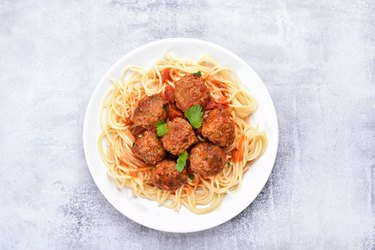
Most home cooks don't have restaurant equipment at their disposal, so if you want to occasionally serve a crowd, you'll need to be creative about how you create and serve large-batch meals. Spaghetti is inexpensive and easy to prepare in bulk, for example, and the roaster oven you use for your holiday turkeys works just fine for keeping the pasta hot.
The Importance of Temperature Management
Video of the Day
Food safety revolves around keeping hot foods hot and cold foods cold. At temperatures of 40 degrees Fahrenheit or below, potentially harmful microorganisms are usually dormant, and their population grows very slowly. At temperatures of 140F or higher, they die off. In between those temperatures is the food safety danger zone, where those nasty bugs can survive and thrive.
Video of the Day
If you're making a massive pot each of sauce and pasta and then keeping them hot until mealtime, your goal is simply to keep the spaghetti and its sauce to a temperature of 140F or above. First, though, you should decide whether you'll use the roaster oven just to keep your pasta hot or to reheat it from refrigerator temperature.
Keeping it Warm vs. Reheating
Using a roaster oven to keep food warm is relatively straightforward. Using it for reheating the meal as well complicates your planning because it adds a few more steps where temperatures must be managed. The first step is preparing your sauce and your pasta. Then you have to cool them quickly and get them into the fridge within two hours so they remain food safe.
You can cool spaghetti rapidly under cold running water and then drain it and toss it with a bit of oil to keep it from sticking. Sauce should be divided into small, flat containers for fast cooling. You might also opt for a prepared sauce out of cans or jars, which saves the added steps of cooking and cooling. If you don't often prepare meals in bulk, saving yourself time and work is a really good idea.
Cooking Spaghetti in a Roaster
If you're preparing and serving the spaghetti right in the roaster, you'll need to take your ingredients from refrigerator temperature to a food-safe temperature. For a full roaster, that takes about two hours. In this case, you'll need to heat up the spaghetti to 165F or beyond, which is the safe temperature for leftovers or reheated foods. Once you've reached that temperature, you again need to only keep it above 140F to maintain food safety.
You don't necessarily have to use long spaghetti noodles either. For a standup buffet, shorter pasta shapes are often better, with less risk to your guests' clothes. Baked ziti in an electric roaster works well, as do similar shapes such as penne or rigatoni.
Keeping Pasta Warm for a Buffet Meal
Because of the lid, you can't just set your roaster to 140F and call it a day. More accurately, it's the fact that the lid can't be on the roaster while people serve themselves, and that means heat will escape from the food's surface. To compensate for heat loss, you'll need to set the roaster's temperature a bit higher, usually 180F to 200F.
The only way to know for sure that you're maintaining a safe temperature is by using a thermometer. Test the pasta in several places to make sure it's hot enough all the way through. It also helps to stir it frequently to avoid hot and cold spots.
Tips and Tricks
Your sauce will begin to dry out as it sits in the roaster, so keep back some extra sauce to moisten it. Alternatively, keep a can or bottle of tomato juice in the kitchen and stir that in as needed. If you have a pasta dish with white sauce, milk can serve the same purpose.
If you plan to refill the buffet, adding new pasta to the old pasta isn't a good idea in terms of quality or food safety. Instead, make up batches in disposable foil pans that fit the roaster. Keep them warm in an oven back in the main kitchen and swap in a fresh one as needed. That's how professionals do it, and as a bonus, it means you won't need to scrape and soak cooked-on sauce from the roaster itself.